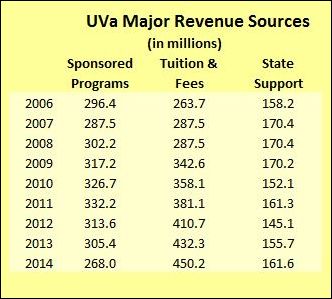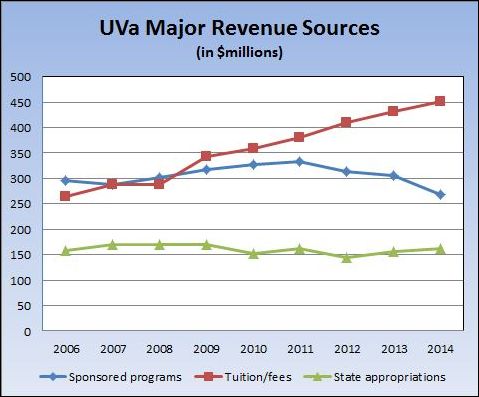by James A. Bacon
While the University of Virginia positions itself in the academic marketplace as an elite Southern Ivy akin to Duke University with the full support of faculty, administrators and the Board of Visitors, students aren’t terribly happy about the rising tuition and fees. The university’s “Affordable Excellence” is long on excellence and short on affordability. Protestors with the student group UVa Students United expressed their displeasure by blocking the doors of the room where the BoV was holding a meeting yesterday, as reported by the Daily Progress today.
Against that backdrop, permit me to present some data to put the tuition hikes into perspective. UVa administrators, like their university brethren across the state, like to blame cuts in state support for skyrocketing tuition and fees. But take a gander at the chart above, with data taken from UVa’s annual President’s Reports (specifics shown below). State appropriations between 2006 and 2014, as seen in the green line, have been stable in absolute terms. The red line shows the steady march of revenue from tuition and fees.

Source: UVa Presidential Reports. Note: These numbers do not count hospital and health system revenues.
What about the blue line? That tracks what administrators call “sponsored programs,” also known before 2010 as “grants & contracts.” After rising steadily through 2011, this category of revenue declined markedly in the past three years — by 19%.
Is there a link between falling grants & contracts and rising tuition? I’d never considered that question before. But a comment to a previous blog post by a certain “ZS” is worth pondering.
I was recently invited to put in for a senior position at UVA and as part of my application research I found that much of their recent financial problems had to do with decreases in grant and contract revenue. Basically, in the past three years UVA’s grant and contract funding is down almost $80M/year (about 4% of operating revenue) and hasn’t been this low in real terms since the mid 1990’s . This loss of revenue equates to roughly $4k/student and looks like it’s being made up through tuition and hospital fee hikes. While some will point to sequestration as a cause, the numbers and the numbers of UVA’s peers in higher education don’t bear this out.
The problems look to be internal and most likely is a lack of leadership accountability. Submitting proposals for grants and contracts is tedious work and not something most people like doing, but it’s important for helping to offset operating costs. If leadership (President and COO) aren’t holding department heads accountable, then it’s very likely that proposals aren’t being done or are being done in a poor, going-through-the-motions manner that doesn’t result in an award (UVA’s award percentage numbers do bear this out).
BTW, state appropriations are less than 5% of UVA’s revenue. Focusing on that portion of UVA’s financials misses where the management issues are in the University. The major tuition hikes aren’t happening because of loss of State appropriations or even from operating cost increases year to year. These are simply distractions to the real issues internally.
This decline in sponsored revenues is consistent with the tumble in UVa’s reported R&D expenditures. According to National Science Foundation data, R&D expenditures fell from $398 million in 2011 to $386 million in 2013, the most recent data available. UVa’s national R&D ranking declined from 54th place to 59th. (However, it must be said that the 2011 numbers represented a huge leap from the previous year, 2010, when R&D expenditures were only $276 million.) By contrast, Virginia Tech increased its R&D expenditures from $450 million to $496 million between 2011 and 2013.
It is noteworthy that UVa President Teresa Sullivan assumed office on August 2, 2010. A surface analysis would suggest that the decline in sponsored-program revenue and R&D funding occurred on her watch. I have seen no evidence in the media coverage that the Board of Visitors has focused on this issue, much less the relationship between declining sponsored revenues and rising tuition & fees. Perhaps it’s time it did.



